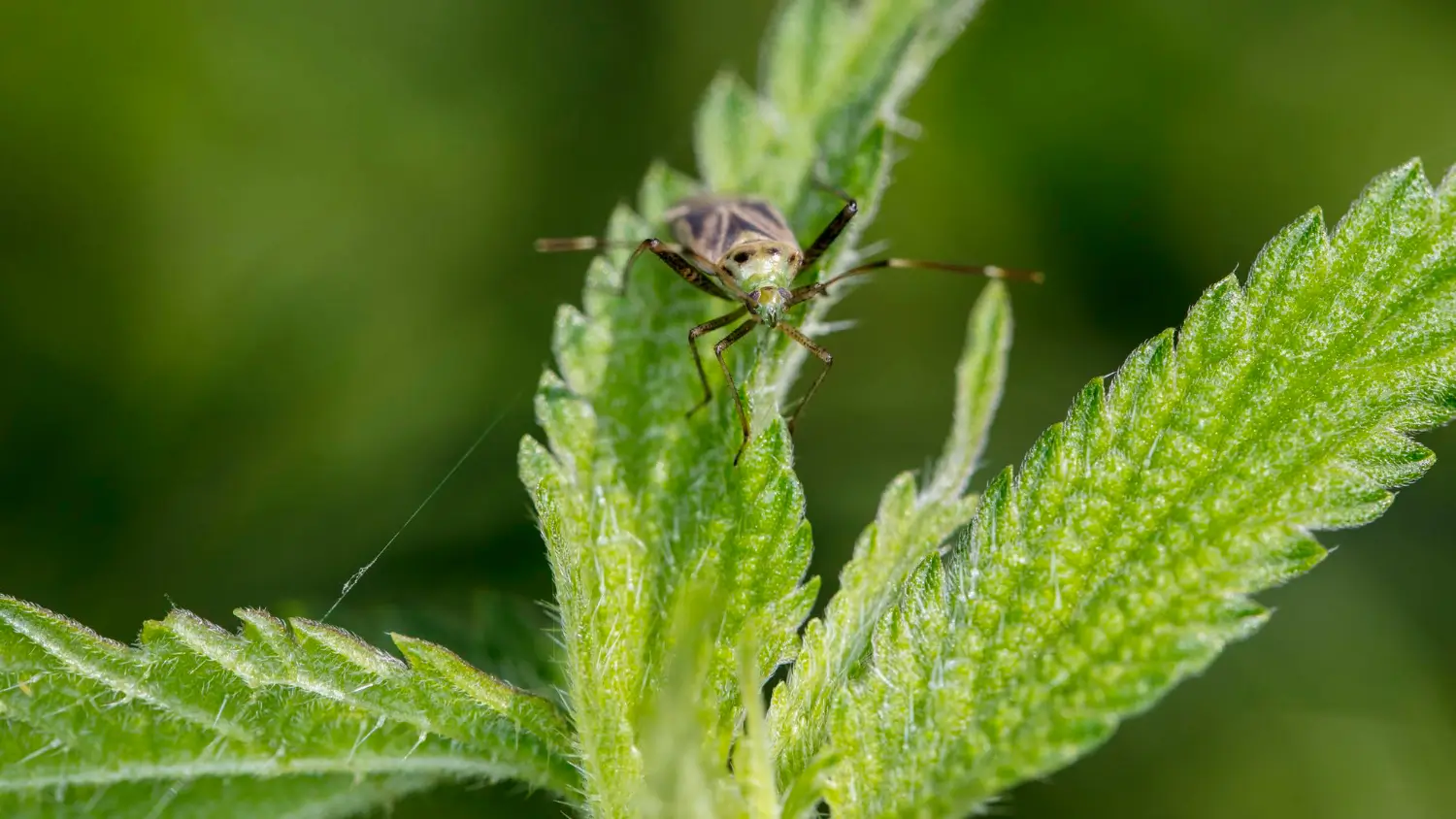
August 24, 2025

A healthy herb garden can provide fresh flavors, natural remedies, and pleasant aromas. Herbs like basil, mint, rosemary, and thyme grow best when they are well cared. However, pests and diseases can quickly harm these plants, causing weak growth, lower yields, and, in some cases, complete plant loss.
Common pests such as aphids, whiteflies, and caterpillars feed on leaves and stems, making plants unhealthy and spreading infections. Diseases like powdery mildew, root rot, and rust also damage herbs by attacking their leaves, stems, and roots. Too much moisture, poor airflow, and unbalanced soil nutrients often make these problems worse.
Identifying and treating such issues at an early stage is important for keeping plants healthy. Growcycle is a B2B marketplace that provides safe, natural ways to protect herb gardens without harmful chemicals.
Pests are a common problem in herb gardens. They are attracted to herbs for food, shelter, and breeding. Some pests suck the sap from leaves, while others chew through stems and roots. If not controlled, they can weaken plants, slow down growth, and reduce harvests.
Aphids are tiny, soft-bodied insects that come in green, yellow, black, or white. They usually gather on the undersides of leaves or along stems. Common symptoms are:
Herbs Affected: Basil, mint, parsley.
Damage: Aphids suck sap from plants, weakening them and spreading diseases. If left untreated, they can destroy an entire herb garden.
Whiteflies are small, white, moth-like insects that live on the undersides of leaves. When disturbed, they fly in a cloud-like pattern. Common symptoms are:
Herbs Affected: Oregano, thyme, rosemary.
Damage: Whiteflies feed on plant sap, reducing plant strength and making them more vulnerable to diseases.
Spider mites are tiny, red, or brown pests that are hard to see with the naked eye. They leave behind fine silk webbing on plants. Common symptoms are:
Herbs at Risk: Dill, cilantro, basil.
Damage: Spider mites suck the juices from leaves, causing them to dry and die. They spread quickly, especially in hot and dry weather.
Caterpillars and armyworms chew large holes in leaves. Some caterpillars eat entire leaves, leaving only the stems behind. Common symptoms are:
Symptoms:
Herbs Affected: Parsley, fennel, basil.
Damage: Caterpillars eat large amounts of plant material, weakening or killing herbs.
Snails and slugs eat soft leaves, especially young plants. They are more active in wet conditions and can quickly destroy an herb garden if not controlled. Common symptoms are:
Commonly Affected Herbs: Basil, mint, thyme.
Certain conditions make herb gardens more inviting to pests:
When pests attack herbs, they cause damage in different ways:
Using chemical pesticides in an herb garden can be harmful, as herbs are often used for cooking and medicinal purposes. So, natural pest control methods can help keep gardens healthy and safe.
Certain plants can repel pests naturally. This technique is called companion planting. Some good plant combinations include:
Some insects help control pest populations by eating them. These include:
Organic sprays can be made at home using simple ingredients:
Preventing pests from reaching plants is an effective way to protect herbs.
Herb plants, like all garden plants, can suffer from diseases that weaken their growth and reduce their harvest. Many of these diseases are caused by fungi, bacteria, or viruses. While some diseases attack leaves and stems, others affect the roots, making it difficult for herbs to absorb nutrients and water.
Powdery mildew thrives in warm, humid conditions with little airflow. It spreads quickly when plants are too close together or if there is too much shade. The fungus grows on the surface of leaves, feeding on plant nutrients. Common symptoms are:
Herbs Affected: Basil, rosemary, sage.
Impact: If untreated, powdery mildew weakens herbs and reduces their flavor and aroma. It does not usually kill plants but can make them unattractive and less productive.
Downy mildew is caused by a fungus-like organism that spreads through water droplets. Wet leaves, overwatering, and crowded plants create the perfect conditions for developing this disease. It spreads quickly during cool, damp weather, especially when there is poor air circulation. Common symptoms are:
Herbs at Risk: Basil, oregano, mint.
Impact: Downy mildew damages the structure of leaves, making it hard for plants to get enough sunlight. Without treatment, the plant will weaken and stop producing fresh leaves.
Root rot is caused by fungi that thrive in overly wet soil. Overwatering, poor drainage, and compacted soil create the perfect environment for these fungi to attack roots. Once the roots are damaged, they cannot absorb water or nutrients properly. Common symptoms are:
Affected Herbs: Rosemary, thyme, chives.
Impact: Root rot affects the plant’s ability to absorb water and nutrients, causing it to weaken. If caught early, the plant may be saved by improving drainage and removing infected roots. However, in severe cases, root rot can kill herbs completely.
Rust disease is caused by a fungal infection that thrives in wet conditions. It spreads through water droplets, especially when leaves remain damp for long periods. Overhead watering and poor airflow increase the risk of infection. Common symptoms are:
Commonly Affected Herbs: Mint, chives.
Impact: Rust disease weakens plants by damaging their leaves, reducing their ability to photosynthesis. The plant may stop growing and produce new leaves if the infection spreads.
Certain environmental factors increase the risk of disease in herb gardens:
Chemical treatments can harm beneficial insects and affect the quality of edible herbs. So, organic methods can help prevent and manage plant diseases while keeping the garden safe and healthy.
Planting herbs with enough space between them allows air to circulate freely. Good airflow helps leaves dry quickly, reducing the risk of fungal infections like powdery mildew and rust.
Some herb varieties are naturally resistant to common diseases. Choosing these varieties can prevent infections before they start. For example, some types of basil are bred to resist downy mildew.
Homemade fungicides can help control fungal diseases without harmful chemicals. Some effective options include:
Keeping the soil healthy is key to preventing diseases. Gardeners can improve soil quality by:
Good gardening habits reduce the chances of pests and diseases attacking herbs. These methods create a strong, balanced environment where plants can thrive.
Stronger plants are less likely to get sick or be attacked by pests. Natural methods for boosting plant immunity can help herbs grow healthier and more resilient.
Compost tea is a liquid fertilizer made by steeping compost in water. It adds nutrients to the soil and strengthens plants against disease. Organic fertilizers, such as fish emulsion, seaweed extract, or worm castings, provide essential minerals that keep herbs strong and healthy. Applying these natural fertilizers regularly helps plants develop deep roots and sturdy stems.
Overwatering is one of the main causes of root rot and fungal diseases. Water herbs in the morning so the leaves have time to dry during the day. Use well-draining soil to prevent water from collecting around the roots. Check the soil by touching it instead of watering it on a fixed schedule. If the top inch is dry, it’s time to water.
A diverse garden naturally controls pests and improves soil health. Planting different types of herbs and flowers together attracts beneficial insects like ladybugs and lacewings, which eat harmful pests. Growing companion plants, such as marigolds or nasturtiums, helps repel unwanted bugs. Avoid using chemical pesticides, as they kill both harmful and helpful insects.
How can pests be controlled naturally?
Use companion planting, beneficial insects, homemade sprays, and physical barriers like netting or copper tape.
What causes diseases in herb plants?
High humidity, poor airflow, overwatering, and contaminated soil often lead to fungal and bacterial infections.
How can herbs be protected from diseases?
Ensure proper spacing, improve soil drainage, use disease-resistant varieties, and apply organic fungicides like baking soda spray.
A well-maintained herb garden can provide fresh, flavorful, and healthy plants for culinary and medicinal use. However, pests and diseases can threaten their growth and yield. By understanding common problems, using natural pest control methods, and following best gardening practices, gardeners can protect their herbs without harmful chemicals. Explore Growcycle to get the best products available for pests and diseases.
Disclaimer: This material is for informational purposes only and should not be relied on for legal, medical, financial, or any other form of professional advice.